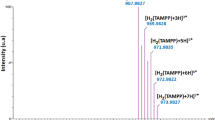Abstract
Mixed-ligand oxovanadium(IV) and oxovanadium(V) complexes with a tridentate dinegative ONO donor Schiff base ligand [viz., 4-(1-hydroxybenzylidenehydrazono)-2-penten-2-ol (H2L)] and bidentate NN [viz., 2,2′-bipyridine (bipy) and 1,10-phenanthroline (phen): complexes (1) and (2), respectively] or OO−[viz., ethylene glycol (H2gol), salicylaldehyde (Hsal) and vanillin (Hvan): complexes (3)–(5), respectively] donor ligands have been prepared and characterized by elemental analyses and by i.r., e.p.r., n.m.r., and u.v.–vis. spectroscopies. The complexes with NN donor ligands are one electron paramagnetic, displaying axial e.p.r. spectra and exhibiting two ligand-field transitions in the visible region, whereas the complexes with OO− donor ligands are diamagnetic and display only LMCT bands. 1H n.m.r. spectral data indicate that the pentavalent complexes (4) and (5) exist in two isomeric forms [(4A), (4B) and (5A), (5B) in 1:1 and 4:1 ratios, respectively]. The vanadyl(IV) complexes display an irreversible oxidation peak near +0.67 V while among the vanadyl(V) complexes, (3), displays an irreversible reduction peak near −0.20 V and (4) and (5) display a quasi-reversible one electron reduction peak near +0.25 V versus s.c.e. The trend in redox potential values and the selective stabilization of VO2+ and VO3+ motifs have been explained on the basis of the basicity of the bidentate auxiliary ligands.
Similar content being viewed by others
References
I. Harvey, J.M. Arber, R.R. Eady, B.E. Smith, C.D. Garner and S.S. Hasnain, Biochem. J., 266, 929 (1990); J. Chen, J. Christiansen, R.C. Tittsworth, B.J. Hales, S.J. George, D. Coucouvanis and S.P. Cramer, J. Am. Chem. Soc., 115, 5509 (1993).
S. Maceds-Ribeiro, W. Hemrika, R. Revirie, R. Wever and A. Messerschmidt, J. Biol. Inorg. Chem., 4, 209 (1999) and references therein.
K.H. Thompson and C. Orvig, J. Chem. Soc., Dalton Trans., 2885 (2000) and references therein.
A. Butler and J.V. Walker, Chem. Rev., 93, 1937 (1993).
N. Bharti, Shailendra, M.T.G. Garza, D.E. Cruz-Vega, J.C. Garza, K. Saleem, F. Naqvi, M.R. Maurya and A. Azam, Bioorg. Med. Chem. Lett., 12, 869 (2002); M.R. Maurya, S. Khurana, Shailendra, A. Azam, W. Zhang and D. Rehder, Eur. J. Inorg. Chem., 1966 (2003).
J.M. Arber, E. de Boer, C.D. Garner, S.S. Hasnain and R. Wever, Biochemistry, 28, 7968 (1989).
M.A. Ali and S.E. Livingstone, Coord. Chem. Rev., 13, 101 (1974).
D.K. Johnson, T.B. Murphy, N.J. Rose, W.H. Goodwin and L. Pickart, Inorg. Chim. Acta, 67, 159 (1982).
K. Srinivasan and S. Perrier, J. Mol. Catal., 36, 297 (1986).
P.K. Bhattacharya, Proc. Ind. Acad. Sci. (Chem. Sci.), 102, 247 (1990).
J.C. Craliz, J.C. Rub, D. Willis and J. Edger, Nature, 34, 176 (1955).
M.J.M. Campbell, Coord. Chem. Rev., 15, 279 (1975).
(a) J. Chakravarty, S. Dutta, A. Dey and A. Chakravorty, J. Chem. Soc., Dalton Trans., 557 (1994); (b) S.P. Rath, S. Mondal and A. Chakravorty, Inorg. Chim. Acta, 263, 247 (1997).
W. Bansse, E. Ludwig, E. Uhlemann, F. Weller, K. Dehnicke and W. Herrmann, Z. Anorg. Allg. Chem., 613, 36 (1992).
S.P. Yan, G.-L. Wang, H.-G. Wang and X.-K. Yao, Chin. J. Struct. Chem., 11, 47 (1992).
W. Wang, F.-L. Zeng, X. Wang and M.-Y. Tano, Polyhedron, 15, 1699 (1996).
A.A. Diamantis, J.M. Frederiksen and Md. Abdus Salam, M.R. Snow and E.R.T. Tiekink, Aust. J. Chem., 39, 1081 (1986).
W. Wang, X. Wang, H.-X. Liu and M.-Y. Tan, J. Coord. Chem., 36, 49 (1995).
M.R. Maurya, S. Khurana, C. Schulzke and D. Rehder, Eur. J. Inorg. Chem., 779 (2001).
S.-X. Liu and S. Gao, Polyhedron, 17, 81 (1998).
R.A. Rowe and M.M. Johnes, Inorg. Synth., 5, 113 (1957).
K. Nakamoto, Infrared and Raman Spectra of Inorganic and Coordination Compounds, 4th edit., Wiley, New York, 1986.
S.P. Perlepes, D. Nicholls and M.R. Harrison, Inorg. Chim. Acta, 102, 137 (1985).
S. Mondal, S.P. Rath, K.K. Rajak and A. Chakravorty, Inorg. Chem., 37, 1713 (1998) and references therein.
S. Mondal, S.P. Rath, S. Dutta and A. Chakravorty, J. Chem. Soc., Dalton Trans., 99 (1996).
M. Chatterjee, S.P. Ghosh, B.M. Wub and T.C.W. Mak, Polyhedron, 17, 1369 (1998); I. Cavaco, J.C. Pessoa, D. Costa, M.T. Duarte, R.D. Gillard and P. Matias, J. Chem. Soc., Dalton Trans., 149 (1994).
C.R. Cornman, J. Kampf, M.S. Lah and V.L. Pecoraro, Inorg. Chem., 31, 2035 (1992).
G.R. Hausen, T.A. Kabanos, A.D. Keramidas, D. Mentzafos and A. Terzis, Inorg. Chem., 31, 2587 (1992).
N.D. Chasteen, in J. Lawrence, L.J. Berliner and J. Reuben, (Eds.), Biological Magnetic Resonance, Plenum, New York, 1981, vol. 3, p. 53.
C.J. Ballhausen and H.B. Gray, Inorg. Chem., 1, 111 (1962).
Author information
Authors and Affiliations
Rights and permissions
About this article
Cite this article
Ghosh, T., Bandyopadhyay, C., Bhattacharya, S. et al. Synthesis, Spectral and Electrochemical Studies of Mixed-Ligand Oxovanadium(IV) and Oxovanadium(V) Complexes Incorporating the Tridentate ONO Donor Schiff Base Derived from Acetylacetone and Benzoylhydrazine. Transition Metal Chemistry 29, 444–450 (2004). https://doi.org/10.1023/B:TMCH.0000027457.32094.aa
Issue Date:
DOI: https://doi.org/10.1023/B:TMCH.0000027457.32094.aa




